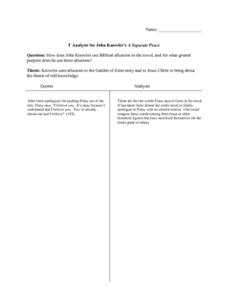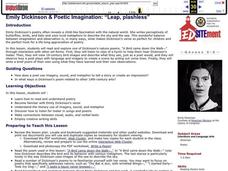National Endowment for the Humanities
Language Analysis Based on Stave 1
Class members meet the original scrooge, the Dickens character whose name has become synonymous with a cold-hearted, tight-fisted, miser. Using the provided worksheet, readers closely examine context clues to determine the meanings of...
Curated OER
"Shooting An Elephant": George Orwell's Essay on His Life in Burma
High school readers examine George Orwell's essay "Shooting an Elephant" for examples of symbolism, metaphor, connotation, and irony. They analyze how these literary tools convey the writer's main point and contribute to the persuasive...
Curated OER
Allegory in Painting
Students examine how allegory is defined and used in the visual arts. They create a list of the arts, and list the objects, symbols, and figures that suggest each art category, analyze various paintings, and identify the allegorical...
Scholastic
Holes Match 'Em Up Challenge
Upper graders read the book Holes as a class or by themselves. In groups, they identify symbols and discuss how they are connected among the many plots in the story. They create a timeline in which they sequence the main...
Curated OER
A Separate Peace - T Analysis
Reading A Separate Peace? Readers analyze important quotes that appear in John Knowle's classic novel using the provided graphic organizer. Learners record a passage and provide an accompanying analysis for each entry. Consider...
Curated OER
Digging Deep for Figurative Language (Hyperbole)
What are hyperboles? Examine the attributes of hyperboles with your high school classes. Pupils read selected poems and prose selections that feature hyperboles and discuss their functions in each work of literature. Specific poems and...
Curated OER
Cartoons for the Classroom: What's Next in 2011?
Examine the toolbox of political cartoons with this analysis handout, which features a cartoon utilizing satire, sarcasm, and irony as it predicts the current events of 2011. Interestingly, this will also serve to get scholars looking...
Curated OER
Literature and Humor
From Canterbury Tales to The Odd Couple, this presentation details the different treatments of humor in different literary formats. Numerous authors and works of literature are represented here as examples of satire, irony, comedy, and...
Curated OER
Nathaniel Hawthorne: "Young Goodman Brown"
Give your class some background information on both Nathaniel Hawthorne and his short story "Young Goodman Brown." Basic themes and characters are introduced, especially as this is an allegory with many symbolic elements. Help your...
Curated OER
Literary Terms
Seriously, 93 slides of literary terms? Yes, and well worth the time, although perhaps not all at once. The beauty here is in the concise, easy-to-understand definitions for such well-known terms as imagery and personification, as well...
Free Library of Philadelphia
Resources for Ghost Boys
Jewell Parker Rhodes, the author of Ghost Boys, wanted to bring the historical legacy of Emmett Till and the current topic of racial prejudice into today's young readers' mindsets. Use a reading guide and set of discussion questions to...
K20 LEARN
Nose Like a Cherry: Understanding Similes and Metaphors
Clement Moore's "Twas the Night Before Christmas" models the power of descriptive language for middle schoolers. They identify the similes and metaphors in the tale and consider what these descriptions add to the story's emotional...
Texas Education Agency (TEA)
Archetypes, Motifs, and Plot in Drama (English II Reading)
The second interactive in a series of 10 introduces young scholars to character archetypes, archetypal plot patterns, and archetypal motifs, including the use of color. Learners read passages explaining the term and study examples from...
Curated OER
Poetry Terms
Give your emerging poets a topic (or have them choose one themselves), and have them play with different poetic devices. They work on alliteration, rhyme, metaphor, personification, simile and onomatopoeia. Consider having them choose...
Curated OER
Understanding King's Use of Metaphors in the
One of the most famous and well-crafted speeches of all time, Dr. Martin Luther King, Jr.'s "I Have a Dream" speech, consists of rich metaphors and rhetorical language. Using a provided graphic organizer, students analyze five quotes...
Curated OER
Using Words: Verbal Communication
Written and verbal communication is the topic for today. The class goes over various facets of verbal communication, such as plain English, active voice, passive voice, cliché, and jargon. They then use those devices as they discuss...
Aurora City School District
Do Not Try to Kid a Kidder: The Art of Persuasion
The power to convince others of your argument lies in your knowledge of rhetoric! A thorough packet covers the basics of persuasion, including logical appeals and fallacies, and applies strategies to letters to the editor,...
PBS
Discuss 22-year-old Amanda Gorman’s inaugural poem “The Hill We Climb”
Two poems by National Youth Poet Laureate Amanda Gorman are spotlighted in a PBS lesson. Young scholars conduct a close reading and watch videos of Gorman reading her inaugural poem "The Hill We Climb" and "The Miracle of Morning." They...
Utah Education Network (UEN)
8th Grade Poetry: Assess
Eighth graders craft a Petrarchan sonnet and respond to a performance assessment to demonstrate what they have learned in this five-activity poetry unit.
Utah Education Network (UEN)
7th Grade Poetry: Ode Poem
Walt Whitman's "Captain, My Captain" and Robert Frost's "The Road Not Taken" provide seventh graders with examples of odes. After reading and discussing these and other examples, young poets craft an ode and respond to the ode of a...
Texas Education Agency (TEA)
Isolated Scenes and Plot Support (English II Reading)
And the plot thickens! The third interactive in this series introduces young scholars to the cause-and-effect nature of a fictional story plot. They learn about the characteristics of exposition, rising action, climax, falling action,...
Curated OER
"Leap, Plashless": Emily Dickinson & Poetic Imagination
Students read and explore one of Emily Dickinson's nature poems, "A Bird Came Down the Walk-" through interaction with a variety of art forms. Clips of a hymn to hear meter and the viewing of bird images exposes them to the language and...
Curated OER
A Lucky Break
Explore idioms with a chicken theme! Consider doing these activities prior to Thanksgiving, as there's a section about wishbones! First your youngsters will match a short list of idioms with their meanings. Then, give each learner the...
Curated OER
Snowy Similes
The class defines similes after creating a KWL chart about them. Groups rotate through a series of stations in which they creatively complete similes. They create a picture booklet that contains similes. However, the booklet topic and...
Other popular searches
- Teaching Literary Devices
- Literary Devices and Terms
- Literary Devices & Quotes
- Common Literary Devices
- Literary Devices and Reading
- Introducing Literary Devices
- Literary Devices Irony
- Glossary of Literary Devices
- Literary Devices Inkheart
- Literary Devices Music
- Literary Device Flashback
- Ell Literary Device Activity

























